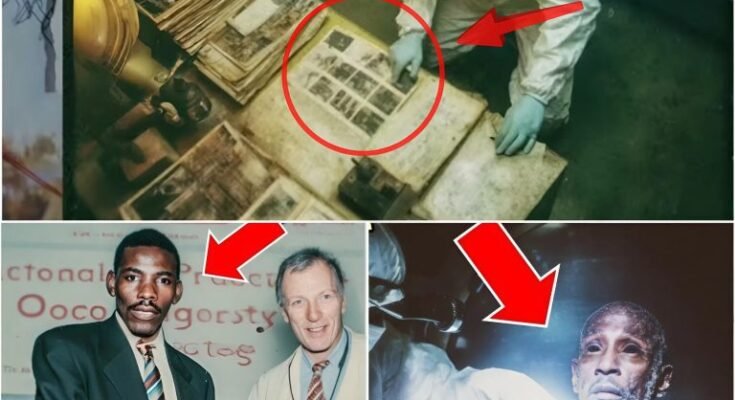JACKSON, MISSISSIPPI — In the summer of 1988, the medical world stood on the brink of a revolution. At the center of it was Dr. Nathaniel Brooks, a brilliant Black oncologist and researcher whose groundbreaking studies on experimental compounds hinted at a potential breakthrough in cancer treatment. Colleagues described him as “ahead of his time, with an unstoppable drive.” Patients called him a miracle worker.
But on a humid June evening, just as whispers of his discovery began to circulate beyond his laboratory, Brooks vanished without a trace. His notes, files, and personal journals were gone. His car was found abandoned near the outskirts of town. Within days, police issued a statement suggesting that the doctor had become “mentally unstable” and had fled, abandoning his family and career.
To many, the explanation felt disturbingly convenient.
The Shadow of Corporate Rivalry
In the years leading up to his disappearance, Dr. Brooks had clashed with executives from Meditronix Pharmaceuticals, a powerful corporation that dominated the cancer drug market. Insiders later revealed that Brooks had rejected lucrative offers to sell his research, insisting his work should be made affordable and accessible.
One former colleague recalled: “They wanted to own him. But Nathaniel wasn’t for sale. He believed medicine belonged to the people, not corporations.”
Within weeks of his disappearance, Meditronix patented a competing drug — one later criticized for its high cost and limited effectiveness. Brooks’s name was quietly scrubbed from medical journals, his legacy reduced to a cautionary tale of “brilliance turned unstable.”
A Decade of Silence
For ten long years, Brooks’s family lived in limbo. His wife, Lorraine, raised their two children under the heavy cloud of rumors and suspicion. “They painted him as a man who walked away,” she said years later. “But I knew Nathaniel. He loved us. He would never abandon his family or his patients.”
Still, without evidence, her protests were drowned out. By the mid-1990s, the story of Dr. Brooks had faded into the archives of unsolved mysteries.
The Heatwave That Changed Everything
In the summer of 1998, a record-breaking heatwave swept across Mississippi. The intense temperatures destabilized abandoned industrial sites, including the decaying research facility where Brooks had last been seen. Local reports described a sudden chemical leak that forced emergency crews to cordon off the area.

Among those dispatched was a special investigative team accompanied by a K-9 search unit. It was during this routine sweep that the dog alerted its handler to something unusual — faint but persistent traces near a collapsed section of the facility.
Digging deeper, investigators uncovered a concealed steel vault door, its edges welded shut and hidden beneath debris. The discovery sent shockwaves through the team. What could be locked away so deliberately for a decade?
The Vault of Secrets
When the vault was forced open, investigators found what appeared to be a sealed underground laboratory. Dusty, untouched, and eerily preserved, it contained remnants of Brooks’s research: test tubes, notebooks, and unfinished experiments.
But the most startling revelation was evidence that someone had lived inside that vault. There were personal belongings — clothes, family photographs, even a child’s drawing pinned to the wall.
The implications were staggering. Had Brooks been imprisoned? Was he forced into silence?
Official records from the investigation remain classified, but multiple sources confirmed that human remains were not found. Instead, investigators recovered biological samples and notes suggesting Brooks had continued his work long after his disappearance.
The Terrifying Truth
Among the documents was a chilling diary entry dated October 1992, four years after Brooks was declared missing. In it, he wrote:
“They will not let me leave. My work is no longer mine. I am trapped in the place I built to heal others.”

Experts who reviewed the recovered files believe Brooks had indeed made significant progress toward a cancer treatment. Yet the secrecy surrounding the vault raised darker questions: Was he silenced by corporate sabotage? Was the facility repurposed to control his research?
The public never received clear answers. The official report cited “insufficient evidence” and quietly closed the case.
A Legacy Revived
Despite the murkiness, the rediscovery of Brooks’s vault reignited debate within the medical and scientific communities. Advocacy groups called for renewed investigation, demanding transparency and accountability from both law enforcement and the pharmaceutical industry.
Dr. Alicia Monroe, an oncologist who studied Brooks’s surviving notes, described them as “remarkably advanced — decades ahead of their time. If pursued, his work might have reshaped cancer treatment as we know it.”
For his family, the discovery was bittersweet. “We may never know the full truth,” said Lorraine Brooks. “But we know now that Nathaniel didn’t abandon us. He fought until the very end.”
Conclusion: A Story That Refuses to Die
Thirty-five years later, the story of Dr. Nathaniel Brooks remains a haunting parable of genius, injustice, and the hidden costs of progress. His name, once erased, is slowly being reclaimed as an emblem of perseverance and sacrifice.
What really happened in that vault between 1988 and 1998? Was it imprisonment, self-preservation, or something even more sinister?
The truth, buried for a decade and shrouded by powerful interests, may never be fully revealed. But one fact is undeniable: Dr. Brooks’s story, like his unfinished research, continues to challenge the world to confront uncomfortable questions about science, power, and the human cost of discovery.


